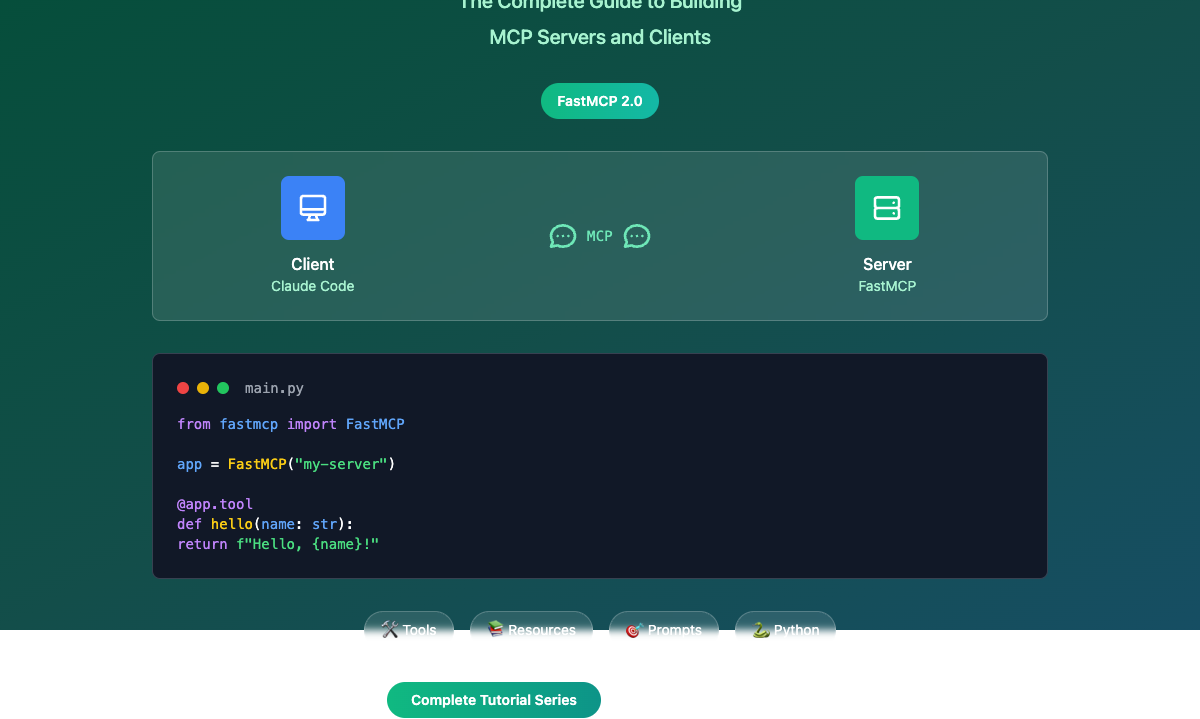课 4
2025-07-03 06:59
将 FastMCP 与 Claude 代码集成
将 FastMCP 与 Claude Code 集成
Claude Code 是 Anthropic 官方支持 MCP 服务器的命令行工具 (CLI),它允许用户通过自定义 FastMCP 服务器扩展 Claude 的功能。这种集成实现了强大的开发工作流,让 Claude 能够访问你的工具、资源和特定领域的功能。
为什么要与 Claude Code 集成?
Claude Code 的集成提供了以下几个引人注目的优势:
- 增强开发工作流:Claude 可以直接访问你的自定义工具。
- 上下文感知协助:Claude 能够读取你的项目资源和配置。
- 自动化任务:通过你的 MCP 工具执行复杂操作。
- 本地和远程支持:可连接本地开发服务器和已部署的服务。
- 实时交互:动态工具发现和执行。
设置 FastMCP 服务器
创建开发服务器
让我们创建一个专为开发工作流设计的综合性 FastMCP 服务器:
# dev_server.py
import os
import subprocess
import json
from pathlib import Path
from datetime import datetime
from fastmcp import FastMCP, Context
mcp = FastMCP(
name="Development Assistant",
instructions="""
此服务器提供开发工具,包括:
- 项目分析和文件操作
- Git 操作和仓库管理
- 代码质量检查和测试
- 环境和依赖管理
"""
)
@mcp.tool
def run_command(command: str, cwd: str = ".") -> dict:
"""执行一个 shell 命令并返回结果。"""
try:
result = subprocess.run(
command.split(),
cwd=cwd,
capture_output=True,
text=True,
timeout=30
)
return {
"command": command,
"returncode": result.returncode,
"stdout": result.stdout,
"stderr": result.stderr,
"success": result.returncode == 0
}
except subprocess.TimeoutExpired:
return {"error": "命令执行超时(30 秒)"}
except Exception as e:
return {"error": str(e)}
@mcp.tool
def analyze_project_structure(path: str = ".") -> dict:
"""分析项目目录结构。"""
project_path = Path(path)
if not project_path.exists():
return {"error": f"路径 {path} 不存在"}
structure = {
"root": str(project_path.absolute()),
"files": [],
"directories": [],
"python_files": [],
"config_files": [],
"total_size": 0
}
config_extensions = {".json", ".yaml", ".yml", ".toml", ".ini", ".cfg"}
for item in project_path.rglob("*"):
if item.is_file():
size = item.stat().st_size
structure["total_size"] += size
file_info = {
"path": str(item.relative_to(project_path)),
"size": size,
"modified": datetime.fromtimestamp(item.stat().st_mtime).isoformat()
}
structure["files"].append(file_info)
if item.suffix == ".py":
structure["python_files"].append(file_info)
elif item.suffix in config_extensions:
structure["config_files"].append(file_info)
elif item.is_dir():
structure["directories"].append(str(item.relative_to(project_path)))
return structure
@mcp.tool
async def check_code_quality(file_path: str, ctx: Context) -> dict:
"""使用各种 linting 工具检查代码质量。"""
await ctx.info(f"正在检查 {file_path} 的代码质量...")
if not os.path.exists(file_path):
return {"error": f"文件 {file_path} 未找到"}
results = {"file": file_path, "checks": {}}
# 使用不同的工具检查
tools = {
"flake8": ["flake8", file_path],
"pylint": ["pylint", file_path, "--output-format=json"],
"mypy": ["mypy", file_path]
}
for tool, command in tools.items():
try:
result = subprocess.run(
command,
capture_output=True,
text=True,
timeout=15
)
results["checks"][tool] = {
"returncode": result.returncode,
"output": result.stdout,
"errors": result.stderr
}
except (subprocess.TimeoutExpired, FileNotFoundError):
results["checks"][tool] = {"error": f"{tool} 不可用或超时"}
return results
@mcp.resource("project://config")
def get_project_config() -> dict:
"""从各种配置文件中获取项目配置。"""
config = {"found_files": [], "configurations": {}}
config_files = [
"pyproject.toml", "setup.py", "requirements.txt",
"package.json", "Dockerfile", ".env", "config.yaml"
]
for config_file in config_files:
if os.path.exists(config_file):
config["found_files"].append(config_file)
try:
with open(config_file, 'r') as f:
content = f.read()
config["configurations"][config_file] = {
"content": content[:1000] + ("..." if len(content) > 1000 else ""),
"size": len(content)
}
except Exception as e:
config["configurations"][config_file] = {"error": str(e)}
return config
@mcp.resource("git://status")
def get_git_status() -> dict:
"""获取当前 Git 仓库状态。"""
try:
# 检查是否在 git 仓库中
subprocess.run(["git", "rev-parse", "--git-dir"],
check=True, capture_output=True)
# 获取各种 git 信息
commands = {
"branch": ["git", "branch", "--show-current"],
"status": ["git", "status", "--porcelain"],
"last_commit": ["git", "log", "-1", "--pretty=format:%H|%an|%ad|%s"],
"remote": ["git", "remote", "-v"]
}
result = {}
for key, command in commands.items():
try:
output = subprocess.run(
command, capture_output=True, text=True, check=True
).stdout.strip()
result[key] = output
except subprocess.CalledProcessError:
result[key] = "不可用"
return result
except subprocess.CalledProcessError:
return {"error": "当前目录不是一个 Git 仓库"}
if __name__ == "__main__":
mcp.run(transport="http", host="127.0.0.1", port=8000)
连接到 Claude Code
运行服务器
首先,启动 FastMCP 服务器:
# 以 HTTP 模式启动服务器
python dev_server.py
你的服务器将在 http://127.0.0.1:8000/mcp/ 运行。
将服务器添加到 Claude Code
使用 Claude Code 的 MCP 管理命令添加你的服务器:
# 添加你的 FastMCP 服务器
claude mcp add dev-assistant --transport http http://localhost:8000/mcp/
# 验证服务器是否已连接
claude mcp list
备选方案:STDIO 传输
对于本地开发,你可能更喜欢 STDIO 传输:
# dev_server_stdio.py
# ... (与上面的服务器代码相同)
if __name__ == "__main__":
mcp.run() # 默认使用 STDIO
将其添加到 Claude Code:
claude mcp add dev-assistant --transport stdio "python dev_server_stdio.py"
使用 Claude Code 访问你的服务器
连接后,你可以通过 Claude Code 与你的 MCP 服务器交互:
基本工具使用
# Claude 会自动发现并使用你的工具
claude "分析我当前的项目结构"
# Claude 将调用你的 analyze_project_structure 工具
# 响应将包含文件数量、大小和组织结构
资源访问
Claude 可以通过 @ 提及来访问服务器的资源:
# 访问项目配置
claude "这个项目有什么配置文件?使用 @dev-assistant:project://config"
# 检查 git 状态
claude "当前的 git 状态是什么?使用 @dev-assistant:git://status"
复杂工作流
结合多个工具进行复杂操作:
claude "请检查 src/ 目录下所有 Python 文件的代码质量并总结问题"
# Claude 将:
# 1. 使用 analyze_project_structure 找到 Python 文件
# 2. 对每个文件使用 check_code_quality
# 3. 总结结果
高级配置示例
带有数据库工具的开发服务器
# db_server.py
import sqlite3
from fastmcp import FastMCP
mcp = FastMCP("Database Tools")
@mcp.tool
def query_database(query: str, db_path: str = "app.db") -> dict:
"""对数据库执行 SQL 查询。"""
try:
conn = sqlite3.connect(db_path)
cursor = conn.cursor()
cursor.execute(query)
if query.strip().upper().startswith("SELECT"):
results = cursor.fetchall()
columns = [description[0] for description in cursor.description]
return {
"columns": columns,
"rows": results,
"count": len(results)
}
else:
conn.commit()
return {"affected_rows": cursor.rowcount}
except Exception as e:
return {"error": str(e)}
finally:
conn.close()
@mcp.resource("db://schema")
def get_database_schema() -> dict:
"""获取数据库模式信息。"""
# 获取数据库模式的实现
pass
if __name__ == "__main_":
mcp.run(transport="http", port=8001)
API 测试服务器
# api_server.py
import requests
from fastmcp import FastMCP, Context
mcp = FastMCP("API Testing Tools")
@mcp.tool
async def test_api_endpoint(url: str, method: str = "GET",
headers: dict = None, data: dict = None,
ctx: Context = None) -> dict:
"""测试 API 端点并返回详细结果。"""
await ctx.info(f"正在测试 {method} {url}...")
try:
response = requests.request(
method=method.upper(),
url=url,
headers=headers or {},
json=data,
timeout=10
)
return {
"url": url,
"method": method.upper(),
"status_code": response.status_code,
"headers": dict(response.headers),
"response_time": response.elapsed.total_seconds(),
"body": response.text[:1000] if response.text else None,
"success": 200 <= response.status_code < 300
}
except Exception as e:
return {
"url": url,
"method": method.upper(),
"error": str(e),
"success": False
}
if __name__ == "__main__":
mcp.run(transport="http", port=8002)
多服务器设置
你可以将多个 FastMCP 服务器连接到 Claude Code:
# 添加多个服务器
claude mcp add dev-tools --transport http http://localhost:8000/mcp/
claude mcp add db-tools --transport http http://localhost:8001/mcp/
claude mcp add api-tools --transport http http://localhost:8002/mcp/
# Claude 现在可以访问所有服务器
claude "检查项目结构,然后测试配置中定义的 API 端点"
常见问题故障排除
服务器无响应
# 检查服务器是否正在运行
curl http://localhost:8000/mcp/
# 移除并重新添加服务器
claude mcp remove dev-assistant
claude mcp add dev-assistant --transport http http://localhost:8000/mcp/
未找到工具
确保你的服务器已正确注册并且工具已用装饰器标记:
# 确保工具已正确装饰
@mcp.tool # 此装饰器是必需的
def my_tool():
pass
资源访问问题
检查资源 URI 格式:
# 正确的格式
claude "使用 @server-name:resource://uri"
# 错误的格式: @server-name/resource://uri
Claude Code 集成最佳实践
- 清晰的工具名称:使用描述性强、不言自明的工具名称。
- 良好的文档:包含全面的文档字符串。
- 错误处理:提供有意义的错误消息。
- 资源组织:使用逻辑 URI 方案来组织资源。
- 性能:保持工具执行时间合理。
- 安全性:验证输入并限制危险操作。
后续步骤
将 FastMCP 服务器集成到 Claude Code 后,你可以:
- 构建特定领域的开发助手。
- 自动化复杂的项目管理任务。
- 创建自定义代码分析和质量工具。
- 开发专门的测试和部署工作流。
在最后一部分,我们将探讨 FastMCP 服务器的高级模式、生产部署和扩展策略。
